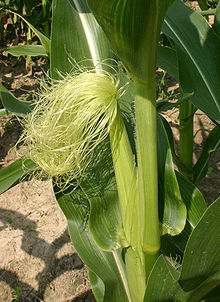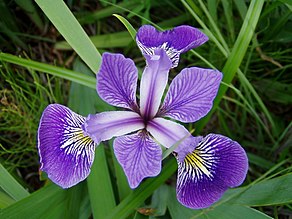Stigma (botany)

The stigma (pl.: stigmas or stigmata)[1] is the receptive tip of a carpel, or of several fused carpels, in the gynoecium of a flower.
Description

The stigma, together with the style and
The stigma receives pollen and it is on the stigma that the pollen grain germinates. Often sticky, the stigma is adapted in various ways to catch and trap pollen with various hairs, flaps, or sculpturings.[3] The pollen may be captured from the air (wind-borne pollen, anemophily), from visiting insects or other animals (biotic pollination), or in rare cases from surrounding water (hydrophily). Stigma can vary from long and slender to globe shaped to feathery.[4]
Pollen is typically highly desiccated when it leaves an anther. Stigma have been shown to assist in the rehydration of pollen and in promoting germination of the pollen tube.
Shape
The stigma is often split into lobes, e.g. trifid (three lobed), and may resemble the head of a pin (capitate), or come to a point (punctiform). The shape of the stigma may vary considerably:[2]

Style
Structure
The style is a narrow upward extension of the ovary, connecting it to the stigmatic papillae. Occasionally, it may be absent, in which case the stigma is described as
Where there are more than one carpel to the pistil, each may have a separate style-like stylodium, or share a common style. In
In Crocus, there are three divided style branches, creating a tube.[11] Hesperantha has a spreading style branch. Alternatively, the style may be lobed rather than branched. Gladiolus has a bi-lobed style branch (bilobate). Freesia, Lapeirousia, Romulea, Savannosiphon and Watsonia have bifurcated (two branched) and recurved style branches.[10][2]
Attachment to the ovary
May be terminal (apical), subapical, lateral, gynobasic, or subgynobasic. Terminal (apical) style position refers to attachment at the apex of the ovary and is the most common pattern. In the subapical pattern, the style arises to the side slightly below the apex. A lateral style arises from the side of the ovary and is found in Rosaceae. The gynobasic style arises from the base of the ovary, or between the ovary lobes and is characteristic of Boraginaceae. Subgynobasic styles characterise Allium.[12]
Pollination
Pollen tubes grow the length of the style to reach the
See also
References
Citations
- ^ "stigma". Oxford English Dictionary (Online ed.). Oxford University Press. Retrieved 2019-03-30. (Subscription or participating institution membership required.) Under 6. Botany: "Plural usually stigmas."
- ^ a b c Dahlgren, Clifford & Yeo 1985, Gynoecium p. 11
- ISBN 0-14-051126-1
- ^ a b Rudall 2007.
- ^ Edlund, Swanson & Preuss 2004.
- ^ González & Arbo 2016, Estilo y estigma
- ^ Klaus Kubitzki (Editor) Flowering Plants. Dicotyledons: Celastrales, Oxalidales, Rosales, Cornales and Ericales, p. 208, at Google Books
- ^ Weberling 1989, pp. 182-186.
- ^ "The Anatomy Of Irises". herbs2000.com. Retrieved 27 July 2015.
- ^ a b Klaus Kubitzki (Editor) Flowering Plants. Monocotyledons: Lilianae (except Orchidaceae), p. 305, at Google Books
- ^ Michael Hickey, Clive King 100 Families of Flowering Plants, p. 562, at Google Books
- ^ Simpson 2011, Style position p. 378
- ^ Christophe Clement, Ettore Pacini, Jean-Claude Audran (Editors) Anther and Pollen: From Biology to Biotechnology, p. 151, at Google Books
Sources
- ISBN 978-3-642-64903-5. Retrieved 10 February 2014.
- Edlund, Anna F.; Swanson, Robert; Preuss, Daphne (2004). "Pollen and stigma structure and function: the role of diversity in pollination". PMID 15075396.
- ISBN 9780521692458. Retrieved 18 January 2015.
- Simpson, Michael G. (2011). Plant Systematics. Academic Press. ISBN 978-0-08-051404-8.
- González, A.M.; Arbo, M.M. (2016). "Botánica Morfológica: Morfología de Plantas Vasculares" (in Spanish). Corrientes, Argentina: Facultad de Ciencias Agrarias, Universidad Nacional del Nordeste. Retrieved 22 June 2016.
- Weberling, Focko (1989) [1981]. Morphologie der Blüten und der Blütenstände [Morphology of Flowers and Inflorescences]. trans. Richard J. Pankhurst. CUP Archive. ISBN 0-521-43832-2. Retrieved 8 February 2014.








